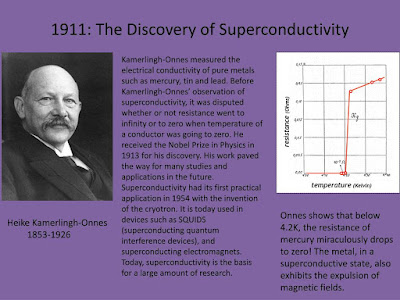Today (September 21, 1853) is the birthday of Heike Kamerlingh Onnes, winner of the Nobel Prize for his study of the properties of materials at superconductivity and low temperature (0K).
Heike Kamerlingh Onnes was born
on September 21, 1853 in Groningen, Netherlands. His father was a Dutchman
named 'Harm Commerling Ans'. He is the owner of a brick kiln. His mother was
'Anna Gertina Choirs'. He and his brothers grew up realizing the strength of
hard work because his parents were strict in all respects. Heike Kamerlingh Onnes
married Maria Adriana Wilhelmina Elizabeth Bislaveld in 1887. He attended
Hoogerberger High School in his hometown. Translation is not taught there. So
to go to school time, at other times, the director of the school, JM Leighton,
who later became a professor of chemistry, studied Greek and Latin alone with
Pemmelen.
In 1878 he joined the College of Technology at Left as an assistant to a scientist named Passa. At the same time he had the opportunity to lecture in 1881-1882. Here he prepared a dissertation entitled General Theory of the Fluids from the Perspective of Kinetic Theory. He realized that accurate measurements of their volume, pressure, and temperature were necessary to formulate the general theory of fluids. Only then did he begin to be interested in knowing and acting on low temperatures. In 1882, at the age of 29, he was appointed professor of experimental physics at the University of Leighton and director of the laboratory there. Here he resumed his studies of low temperatures. This is called hypothermia. For almost 42 years (1882-1923) he spent most of his life in the same Leyton laboratory.
Low thermodynamics was a new
field at the time. Prior to this, liquefaction of gases at low temperatures was
not practiced. When Kamerlingh conducted this study, he wanted to know the full
research evidence of the atomicity of matter. He studied the exposure of gases
such as oxygen, hydrogen, and helium to very low temperatures. At this point,
the Swedish scientist RP Fiktet discovered that there was a cooling effect when
the liquid evaporated. In the same year, the French physicist LP Keitlet
discovered that low temperatures were formed when oxygen was subjected to high
pressure. Finally, J.P. Jules and William Thompson (Lord Kelvin) discovered
that when a gas is injected at a high pressure through a very small opening,
its temperature decreases according to the nature of the gas. In 1895, Carl
Linde in Munich developed a gas liquefaction device based on the Joule-Thompson
effect.
Kamerlingh invented a new method by combining the methods of Pickett and Linde. According to this he succeeded in liquefying oxygen, which liquefies other gases. He liquefied 14 liters of oxygen in an hour. In 1904 he established the largest laboratory for the formation of low temperatures. In 1908, Hampson-Linde designed the instrument to lower the temperature by 1 degree (-273) using the Joule-Thompson effect according to the rotation method. It is housed in the Poirhall Museum in Leighton. He was awarded the Nobel Prize in 1913 for these studies. In 1911 he researched the resilience of pure metals such as mercury, silver and lead. Kamerlingh and his assistants found that the resistor rotates at a temperature of 4.2 Kelvin. Mercury reaches this new state and its electrical conductivity improves. This is referred to as the superconductivity.
The Low Temperature Laboratory at the University of Leighton is named after Kamerlingh Onnes. He was awarded the Mathews Medal in 1910 and the Rambord Medal in 1912. He named a crater on the moon. He was inducted into the Royal Academy of Sciences of Amsterdam at the age of 30. He also founded an international association. He served as Commanding Officer of the Arima Team of the Netherlands, the Orange-Nassau Team of the Netherlands, the St. Aloff Team of Norway, and the Bolenia Restiuba Team of Poland. University of Berlin conferred honorary doctorate. The Bowmgarden Prize and the Franklin Medal were awarded.
Elected a member of the Friends
of Science Association in Moscow. He was employed as an expatriate member in
foreign cities such as Rome and London and as an appraisal member of the
Physics Society in Stockholm. Although a scientist he focused more on his
family life. He did all he could to help those in need. He helped to bridge the
gap between scientists and politicians before and after World War I. Heike Kamerlingh
Onnes, winner of the Nobel Prize for his study of the properties of matter at
low temperature (0K), died in the Netherlands on February 21, 1926, at the age
of 72. Postage stamps were issued in his honor.
Source By: Wikipedia
Information: Ramesh, Assistant
Professor of Physics, Nehru Memorial College, Puthanampatti, Trichy.







.jpg)

No comments:
Post a Comment